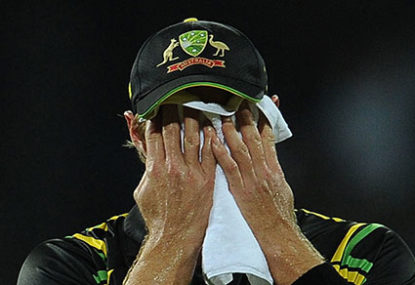Expert

Twenty20 cricket has become the whipping boy for everything that’s wrong with Australian cricket.
Just yesterday on The Roar, two colleagues, experts Cam Rose and Kersi Meher-Homji, wrote pieces in which they suggested the performances of the Test team, particularly the fragility of Australia’s top six batsmen, can be attributed to the rise of the Big Bash League.
As with most problems, I believe it is more complex and layered than just one variable.
Though I don’t deny Twenty20 – and in particular, Cricket Australia’s scheduling of the Big Bash League – has had, and will have, an impact on the Test team, it is merely just one of a number of issues negatively affecting the Australian cricket team’s performance at present.
I don’t believe that Twenty20 cricket contributed to:
– Chris Rogers leaving a straight one off Graeme Swann.
– Shane Watson’s selfish use of the DRS, and the rest of the team’s outright poor use of it.
– Australia changing its batting line-up every Test.
– The team not respecting Mickey Arthur.
– The selectors using Twenty20 performances as a guide for Test match performances.
– Shane Watson and Michael Clarke’s personality clash.
– Ryan Harris’ inability to stay on the field.
– The mistake of naming the captain as a selector.
– Brad Haddin’s poor keeping.
– Mike Hussey and Ricky Ponting retiring.
– The Argus Review, and how a lot of changes from it have been overturned.
– Craig McDermott leaving as bowling coach.
– A overly-optimistic celebration of Ashton Agar as the new Sir Garfield Sobers.
– Usman Khawaja’s treatment by selectors.
– Expecting a solid first class cricketer like Ed Cowan to be a good Test batsman.
– Michael Clarke’s back issues.
– The premature dumping of Simon Katich.
– James Anderson becoming a world class swing bowler.
– The selection of Glenn Maxwell (actually, that one might be Twenty20’s fault!).
I could go on…
There are many issues that have led to the situation the Test side finds itself in. Perhaps Twenty20 is one of them – especially when it comes to the top six’s batting – but I’m not sure I’d even rank it near the top ten explanations for the Test team’s current predicament; though it is hard to quantify such things.
It’s also worth noting Twenty20 exists because there is a market for it. Plain and simple.
Cam stated yesterday if you watch the BBL, you’re contributing to the demise of Australia’s Test cricket side. Though I find that to be slight hyperbole (sorry Cam!), I get the point he was trying to make.
My counter would be that humans are meant to evolve. Out physiological and psychological advantage is that we can adapt to our environment and any changes to it.
Twenty20 is not going anywhere, for the time being anyway. As such, we need to adapt to this reality. That goes for the fans and the players, particularly the batsmen.
During the course of a Test match innings, a batsman is required to have gears; to be able to adapt to the match conditions and situations, and play accordingly.
If quick runs are required, batsmen need to have the stroke-play and ability to up the tempo of their innings.
Likewise, on occasions batsmen need to dig in. To see off a threatening opening bowler, to not lose another wicket before lunch, to sacrifice runs for mere survival, to graft out an innings.
Great Test batsmen are capable of adapting to the circumstances.
I see no difference between the adaptability required within a Test match innings, and the need to adapt between formats.
I stress once again the reality that Twenty20 exists. It’s a format in the cricketing world, and it’s not going anywhere.
Furthermore, if you’re successful at Twenty20, you can earn enough money to set you and your family up for life. In that regard, it is an opportunity that shouldn’t be squandered by a professional cricketer.
The overwhelming majority of cricketers in Australia aspire to wear the baggy green. They probably also enjoy the game of Twenty20, and the opportunities it can provide.
Runs remain a batsman’s currency in either format, but if they have even a shred of common sense, they would be aware the two formats require the same fundamental skills, but different applications of them.
Should they desire to play both, they need to be fully aware that a different approach and mindset is required for each.
If batsmen want to approach Test batting like they do Twenty20 batting, that’s their choice. But with that choice comes the reality that if they consistently get out playing a loose shot after facing 30 balls, their Test career will be over in a hurry.
If they want to approach Twenty20 batting like they do Test batting, that’s also their choice. But with that choice comes the reality that if they struggle to consistently score runs quickly, their Twenty20 career will be over in a hurry.
The harsh reality is that a cricketer’s destiny, especially a batsman’s, is in their own hands. Or gloves.
Ian Chappell often says – and he’s backed up by other experts – that the most rewarding shots in Twenty20 remain good cricket shots that you would play in Test cricket.
So I don’t buy the notion that batting between the two formats is vastly different.
What changes is the application of skills; the judgment of what shots to play and when to play them. Quite simply, batsmen need to learn and adapt.
Cricketers are paid handsomely in the modern era. If they wish to continue to be well paid, they need to be successful at both formats, which means they need to learn and adapt.
Blaming failure in one format on the other format is lazy, and just a poor excuse for an inability to – you guessed it – learn and adapt.